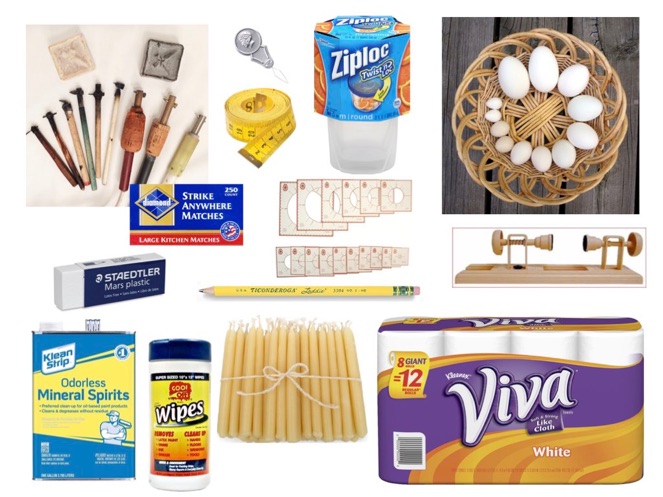Teaching Pysankarstvo:
Supplies
Teaching Pysankarstvo:
Supplies


Gathering your supplies
Gather all of your supplies in advance and, if your are going to be teaching away from home, pack them into a sturdy container. I use several of those large plastic storage totes you can buy at most discount stores. One with clear plastic sides is nice, as you can glance and see what is inside, but opaque works well, too. Make sure it is study.

I keep my basic class supplies in two medium sized plastic storage containers; I used to keep them in one, but then I got old, and it became too heavy to carry.
You will need, minimally, the following items:
General supplies for common use
Table covering (plastic table cloths are usually best)
Paper towels or cheap toilet paper (for drying eggs)
1 set dyes, premixed*, in jars
1 jar vinegar rinse (water + vinegar)
Spoons, metal, one per dye + vinegar rinse
Lighter or Matches
Instruction sheets/booklets, design sheets
Egg carton egg holders for table
Cleaning wire(s)
(Red Solo cups or plastic water glasses)**
(Plastic water pitcher)**
Pencil sharpeners
Fine and heavy styluses (several for each table)
And, for each student, you will need one each of the following
1 medium stylus
1 block beeswax
1 beeswax holder per student (paper cupcake liners work well)
1 candle***
1 candle holder***
1 pencil, sharpened
2 eggs (or more, depending on time allowed for class, and allowing for breakage)
Container for egg (more here)
Additionally, useful but not mandatory items include
1 plastic placemat per student
Craft lathe****
Books, posters
Instructional video
Heavy and fine styluses
Vinegar
Goof-Off wipes
Goo-Gone (small bottle, for removing residual wax)
It’s probably best to keep your dyes in a separate box from the rest of your supplies, in case there is leakage. I use tightly sealing plastic containers for my dyes, both to prevent breakage of the jars, and to keep the dye from leaking. Ziplock (or similar) quart containers work quite well for this purpose. I pack dyes separately, usually in a produce box (with handles) or handled plastic tote.
There will be further discussion on the following pages of how to set up the dye table, how set a place for each students, and how to use the supplies most efficiently.
NOTES:
* You can mix the dyes on site if you have the time and proper facilities. I will sometimes take my electric kettle, jars and dyes with me and mix them on site. I label the jars in advance if possible. I usually do this in those situations where I will leave the dyes behind (e.g. at an art center where I teach) or get rid of them after class.
** If you are using emptied eggs, you will need something to weigh the eggs down while in the dye. Red Solo cups or plastic drinking glasses are good for this. They will need to be filled partially with water; that is why it’s handy to have a pitcher of water at your dye table.
*** In a pinch, students sitting across the table from each other, if the table is narrow, can share a candle. So may students sitting next to each other. It reduces jostling and breakage, though, if each student has his own candle.)
**** A craft lathe is useful for helping students draw guidelines/divisions on their eggs. I no longer bring one, as I mark all the eggs ahead of time with a Basic 8 division.
Back to Main Teaching page
Back to Main Pysankarstvo page
Search my site with Google
What will you need?